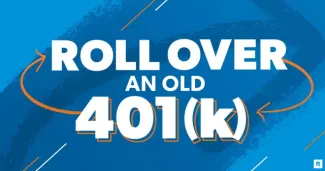
How to Roll Over Your Old 401(k)
Forty-seven million. That’s how many people left their jobs in 2021 at the height of the Great Resignation. And millions more are planning to quit this year.
While there’s nothing wrong with blazing new career paths, many of those folks are leaving a trail of forgotten 401(k)s, sometimes with thousands of dollars in retirement savings left behind. Maybe you’re one of them!
If you’ve got money gathering dust in a long-forgotten retirement account, it’s time to find it a new home. That’s where a 401(k) rollover comes in.
What Is a 401(k) Rollover?
A 401(k) rollover simply allows you to transfer your retirement savings from a 401(k) you had at a previous job into an IRA or the 401(k) at a new job. And you won’t have to pay any taxes on the money you transfer (in most cases).
Rolling Over a 401(k): What Are Your Options?
Let’s say you’re starting a new job and you’re wondering what to do with the money in a 401(k) you had at an old job. You have four options:
- Option 1: Cash out your 401(k).
- Option 2: Do nothing and leave the money in your old 401(k).
- Option 3: Roll over the money into your new employer’s plan.
- Option 4: Roll over the funds into an IRA.
Option 1: Cash out your 401(k).
Let’s get this out of the way—this is the worst thing you can do with your old 401(k).
If you withdraw the money from your 401(k) plan and take a direct cash distribution, you’ll have to pay any state and federal income taxes you owe on every last penny. And if you’re under 59 1/2 years old, you can go ahead and add another 10% early withdrawal penalty to your tab.
But the worst part is you’re robbing yourself of the chance to continue earning tax-free or tax-deferred growth on your investments for years, maybe decades. It’s just a bad idea all around, folks.
Option 2: Do nothing and leave the money in your old 401(k).
Now, you could just leave the money in your old 401(k) if you’re really happy with your investments and the fees are low.
Option 3: Roll over the money into your new employer’s plan.
Rolling your money over to your new 401(k) plan has some benefits. It simplifies your investments by putting them in one place. And you also have higher contribution limits with a 401(k) than you would with an IRA—which means you can save more!
But there are lots of rules and restrictions for rolling money over into your new employer’s plan, so it’s usually not your best bet. Plus, your new 401(k) plan probably only has a handful of investing options to choose from too. And if you’re feeling iffy about those options, why put all your retirement savings there? Which brings us to . . .
Option 4: Roll over the funds into an IRA.
Most of the time, transferring the money from your old 401(k) into an IRA is your best option. That’s because an IRA gives you the most control over your investments.
You see, an IRA gives you potentially thousands of mutual funds to choose from. You can pick from the best of the best instead of just a few so-so options. You can work with an investment professional who can walk you through the rollover and help you manage your investments for the long haul—no matter where your career takes you.
How to Roll Over a 401(k) Into an IRA
Okay, now it’s time to get the ball rolling! Once you’re ready to do a 401(k) rollover, you can get the money transferred to your new retirement account in just four easy steps:
1. Decide between a traditional or Roth IRA.
The type of IRA you roll your old 401(k) money into will depend on what kind of 401(k) you’re transferring the money from.
In most cases, if you have a traditional 401(k), you’ll probably want to roll the money into a traditional IRA. That way, you won’t have to pay any taxes on the transfer (you’ll pay taxes later when you take the money out in retirement, though).
If you had a Roth 401(1), that’s a different story. You could roll the money you contributed into a Roth IRA
completely tax-free and continue to enjoy tax-free growth and tax-free withdrawals in retirement. But your employer’s contributions are treated like traditional 401(k) contributions . . . so that money needs to either be rolled over into a traditional IRA or you can pay the taxes to roll them into a Roth account.
Easy, right? Traditional to traditional, tax-free today. Roth to Roth, mostly tax-free today and tax-free in retirement.
2. Open the IRA account.
Opening a rollover IRA can be as simple as visiting a bank or brokerage firm’s website and filling out an application online. But the best way to start an IRA is to talk with your investment professional.
Side note: If you already have an IRA, you can simply work with your pro to transfer the funds into your existing account—no need to create a new one!
3. Request a direct transfer rollover from your old 401(k).
Remember, you need to ask for a direct transfer rollover from the plan administrator of your old 401(k)—this could be your old employer or a third party. They’ll give you a form to fill out that will usually ask you to provide your contact information and account information for the plan you’re transferring money from and the account you’re transferring the money to.
4. Choose your investments.
When it comes to investing, your IRA or 401(k) is like a grocery bag—and your investments are the groceries that go inside it. Now that you’ve got the ball rolling on your rollover, it’s time to pick and choose what goes inside your bag!
You’ll want to evenly spread out your investments between four different types of growth stock mutual funds:
- Growth and income (or large-cap) funds
- Growth (or mid-cap) funds
- Aggressive (or small-cap) growth
- International funds
Look for funds that have a long track record of strong returns, meaning the fund is at least 10 years old and regularly outperforms other funds in its category.
What Are the Advantages of a 401(k) Rollover?
At the end of the day, a 401(k) rollover makes your life a whole lot easier and simpler in three huge ways. And when it comes to investing, you definitely want to keep it simple!
1. You can manage all your investments in one place.
A recent study found that the youngest baby boomers worked 12 different jobs over the course of their careers. Did you hear that? Twelve! Imagine how difficult it is to keep track of a dozen 401(k)s from previous jobs.
The more scattered your retirement accounts are, the harder it is to make good decisions about your investments—and that can affect your retirement future. You’ll be able to manage your retirement funds better by having them all in one place.
2. You’ll have more investment options to choose from in an IRA.
The more investment options you have, the more likely you are to make better decisions. That’s why Dave likes to say if you have two bad options in front of you, go look for better ones!
Like we mentioned before, rolling your old 401(k) funds into an IRA means you have thousands of mutual funds to choose from instead of the handful of options you had in your old workplace plan.
3. You’ll have more control over your investments.
If you already have an investment professional, a 401(k) rollover allows you to move those funds into an account that’s already under their management. That way, you can work closely with your advisor to invest that money the way you want to.
Get Help With Your 401(k) Rollover
Having an investment professional in your corner, someone who can help you find the right investments to add to your portfolio and walk you through all the ins and outs of a 401(k) rollover, makes this process a lot easier.

